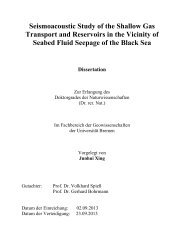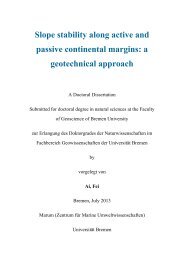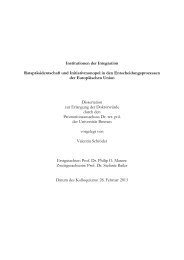aus dem MARUM und dem Fachbereich Geowissenschaften der ...
aus dem MARUM und dem Fachbereich Geowissenschaften der ...
aus dem MARUM und dem Fachbereich Geowissenschaften der ...
Create successful ePaper yourself
Turn your PDF publications into a flip-book with our unique Google optimized e-Paper software.
MARIA S. MERIAN-Berichte, Cruise 20, Leg 4, Bridgetown – Freeport, 15.3.2012 – 7.4.2012<br />
6.4.2. The Bimini Slope: The Water Column Structure<br />
(Christian Dullo, Silke Glogowski, Thorsten Garlichs)<br />
Off Bimini only one CTD station was performed (GeoB 16356). The upper 70 m of the water<br />
column are obtained by Florida Current Surface Water (FCSW) with the lowest salinities aro<strong>und</strong><br />
36.14 in water depth of 70 m (see Fig. 6.26). Here, the FCSW is typically influenced by the<br />
Antilles Current. Below 152 m follows the Subtropical Un<strong>der</strong>water (SUW; salinity: 36.90).<br />
Decreasing salinities towards the deep (minimum salinity in 748 m water depth: 34.94) mark the<br />
lower portion of the SUW that is already influenced by the Antarctic Intermediate Water<br />
(AAIW), although this water mass was not clearly identified in this station. For a comparison<br />
with the following CTD station in the next working area slightly further south, the Great Bahama<br />
Bank area, see chapter 6.5.2.<br />
6.4.3 The Bimini Slope: Bathymetry and Sub-Seafloor Structures<br />
(Gregor Eberli, Paul Wintersteller, Dierk Hebbeln)<br />
The mo<strong>der</strong>n slope of the western Great Bahama Bank (incl. the northern Bimini Slope) is the last<br />
one of a series of prograding clinoforms that advanced the platform margin more than 25 km<br />
towards the west during the last 12 Myr (Eberli & Ginsburg, 1987; Anselmetti et al., 2000). The<br />
mo<strong>der</strong>n slope receives large amounts of fine-grained sediment with up to 90 m accumulation<br />
during the Holocene (Wilber et al., 1990) but the ol<strong>der</strong> strata also contain ab<strong>und</strong>ant calcareous<br />
turbidites and slump units (Betzler et al., 1999). The recently obtained MBES bathymetry map of<br />
Mul<strong>der</strong> et al. (in press) documents that large-scale slope failures and mass transport complexes<br />
occur along the mo<strong>der</strong>n carbonate slope. During cruise MSM20-4 it could be <strong>dem</strong>onstrated that<br />
these erosional products are the core of the numerous mo<strong>und</strong> structures observed in the MBES<br />
data and formerly be interpreted as CWC mo<strong>und</strong>s. Two ROV dives along the Bimini Slope<br />
revealed that these mo<strong>und</strong>s are sparsely covered by CWC or even nearly barren of any CWC<br />
colonisation and that these mo<strong>und</strong>s (at least most of them) are most probably not formed by coral<br />
fragments and hemipelagic sediments (see chapter 6.5).<br />
North of Bimini the slope is dissected by a series of shallow canyons that originate in a 30km-long<br />
array of scars at the upper slope in a water depth of ~450 m (Fig 6.22). The canyons<br />
run west down slope and bend slightly to the south. Numerous mo<strong>und</strong> structures with heights<br />
of >100 m were fo<strong>und</strong> at the canyons' mouth and along the canyons' flanks. Three different sites<br />
were defined for detailed studies within this 30x30-km-sized Bimini Slope region (Fig. 6.22).<br />
The first site is located close the toe-of-slope including a 100-m-high mo<strong>und</strong> named<br />
“Wienberg mo<strong>und</strong>”. The second area is characterised by a cluster of mo<strong>und</strong>s at the confluence<br />
of three canyons and is situated in the middle of the entire canyon system. However, this site<br />
was not investigated by sampling as ROV dives in sites 1 and 3 revealed that the mo<strong>und</strong>s as<br />
large boul<strong>der</strong>s with scarce or no coral coverage. The third site comprises the upper end of the<br />
canyons below the erosional scar.<br />
The MBES bathymetry map acquired on board R/V MARIA S. MERIAN illustrates the slope<br />
with its large anastomosing canyon system in great detail (Fig. 6.21). The canyons are bifurcating<br />
and at the lower slope they bend to the south. Large mo<strong>und</strong>ed features of the "Mul<strong>der</strong><br />
map" (Fig. 6.22) are here recognizable as blocks and boul<strong>der</strong>s. The entire system seems to have<br />
very little fine-grained off-bank transported sediment that is smothering mo<strong>und</strong>ed features<br />
37

















